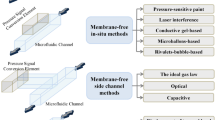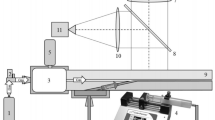Abstract
A novel design for a microrheometer is simulated and tested using finite element modeling techniques. Non-Newtonian fluid obeying the Carreau viscosity model is driven through a microchannel T-junction using electro-osmosis. A range of shear rates, and hence viscosities, is produced as the fluid is forced to turn the corner of the T-junction. Thus, the design has the potential to enable the constitutive viscous parameters to be determined from a single microfluidic experiment. Three-dimensional simulations are performed for a broad range of Carreau constitutive parameters. The pressure fields on the microchannel walls, floor, and ceiling are shown to be sensitive to the Carreau parameters that determine the fluid’s shear-thinning behavior. The fluid dynamics theory and numerical results described in this article pave the way for a detailed analysis of the corresponding inverse problem, that is, to determine the values of the Carreau constitutive parameters from the pressure field measured by optimal positioning of cheap piezo electric pressure transducers embedded into the inner surface of the microchannel network.







Similar content being viewed by others
Notes
SPOOLES is a library for solving sparse real and complex linear systems of equations, written in the C language, and is available from http://www.netlib.org/linalg/spooles/.
References
Bandulasena HCH, Zimmerman WB, Rees JM (2008) An inverse methodology for the rheology of a power-law non-Newtonian fluid. J Mech Eng Sci 222(C5):761–768
Bandulasena HCH, Zimmerman WB, Rees JM (2009) Microfluidic rheometry of a polymer solution by micron resolution particle image velocimetry: a model validation study. Meas Sci Technol 20:115405 (9 pp). doi:10.1088/0957
Bandulasena HCH, Zimmerman WB, Rees JM (2010) Towards an integrated microfluidic device for rheological parameter estimation. J Non-Newtonian Fluid Mech (submitted)
Craven TJ, Rees JM, Zimmerman WB (2008) On slip flow velocity boundary conditions for electro-osmotic flow near sharp corners. Phys Fluids 20(4):043603
Degre G, Joseph P, Tabeling P, Lerouge S, Cloitre M, Ajdari A (2006) Rheology of complex fluids by particle image velocimetry in microchannels. Appl Phys Lett 89:024104
Devarakonda B, Han J, Ahn CH, Banerjee RK (2007) Bioparticle separation in non-Newtonian fluid using pulsed flow in micro-channels. Microfluid Nanofluid 3:391–401
Emakov SV, Jacobson SC, Ramsey JM (1998) Computer simulations of electrokinetic transport in microfabricated channel structures. Anal Chem 70:4494–4504
Gao Y, Wong TN, Chai JC, Yang C, Ooi KT (2005) Numerical simulation of two-liquid electro-osmotic flow in microchannels. Int J Heat Mass Transfer 48:5103–5111
Gavrus A, Massoni E, Chenot JL (1996) An inverse analysis using a finite element model for identification of rheological parameters. J Mater Process Technol 60(1):447–454
Guillot P, Panizza P, Salmon JB, Joanicot M, Colin A, Bruneau CH, Colin T (2006) Viscosimeter on a microfluidic chip. Langmuir 22(14):6438–6445
Horiuchi K, Dutta P (2004) Joule heating effects in electro-osmotically driven microchannel flows. Int J Heat Mass Transfer 47:3085–3095
Hunter RJ (1992) Foundations of colloid science, vols I–II. Oxford University Press, Oxford
Kang K, Lee LJ, Koelling KW (2005) High shear microfluidics and its application in rheological measurement. Exp Fluids 38:222–232
Lee J, Tripathi A (2005) Intrinsic viscosity of polymers and biopolymers measured by microchip. Anal Chem 77(22):7137–7147
MacInnes JM (2002) Computation of reacting electrokinetic flow in microchannel geometries. Chem Eng Sci 57:4539–4558
MacInnes JM, Du X, Allen RWK (2003) Prediction of electrokinetic and pressure flow in a microchannel T-junction. Phys Fluids 15:1992–2005
MacInnes JM, Du X, Allen RWK (2003) Dynamics of electro-osmotic switching of reacting microfluidic flows. Chem Eng Res Des 81(A7):773–786
Owens RG, Phillips TN (2005) Computational rheology. Imperial College Press, London
Pujos C, Regnier N, Mousseau P, Defaye G, Jarny Y (2007) Estimation of rheological law by inverse method from flow and temperature measurements with an extrusion die. In: MATERIALS PROCESSING AND DESIGN; Modeling, Simulation and Applications, NUMIFORM ’07; Proceedings of the 9th international conference on numerical methods in industrial forming processes. AIP Conference Proceedings, vol 908, pp 1287–1294. doi:10.1063/1.2740987
Rawool AS, Mitra SK (2006) Numerical simulations of electro-osmotic effect in serpentine channels. Microfluid Nanofluid 2(3):261–269
Rawool AS, Mitra SK, Kandlikar SG (2006) Numerical simulation of flow through microchannels with designed roughness. Microfluid Nanofluid 2(3):215–221
Richardson JF, Chhabra RP (2008) Non-Newtonian flow and applied rheology, 2nd edn. Butterworth-Heinemann, Oxford, 501 pp
Srivastava N, Burns MA (2006) Analysis of non-Newtonian liquids using a microfluidic capillary viscometer. Anal Chem 78(5):1690–1696
Szeliga D, Gawad J, Pietrzyk M (2006) Inverse analysis for identification of rheological and friction models in metal forming. Comput Methods Appl Mech Eng 195:6778–6798
Tang GY, Yang C, Chai CK, Gong HQ (2004) Joule heating effect on electro-osmotic flow and mass species transport in a microcapillary. Int J Heat Mass Transfer 47:215–227
Tanner RI (2002) Engineering rheology, 2nd edn. Oxford University Press, Oxford, 592 pp
Tuinier R, Taniguchi T (2005) Polymer depletion-induced slip near an interface. J Phys: Condens Matter 17:L9–L14
Zimmerman WBJ (2006) Multiphysics modelling with finite element methods. Series on stability, vibration and conrol of systems, series A, vol 18. World Scientific, Singapore, 432 pp
Zimmerman WB, Rees JM, Craven TJ (2006) The rheometry of non-Newtonian electrokinetic flow in a microchannel T-junction. Microfluid Nanofluid 2:481–492
Acknowledgments
WZ acknowledges support from EPSRC Grant Nos. GR/A01435 and GR/S83746. TC would like to thank the University of Sheffield for a doctoral scholarship. We acknowledge support from the EPSRC Grant EP/E01867X/1 (Bridging the Gap between Mathematics, ICT and Engineering Research at Sheffield).
Author information
Authors and Affiliations
Corresponding author
Rights and permissions
About this article
Cite this article
Craven, T.J., Rees, J.M. & Zimmerman, W.B. Pressure sensor positioning in an electrokinetic microrheometer device: simulations of shear-thinning liquid flows. Microfluid Nanofluid 9, 559–571 (2010). https://doi.org/10.1007/s10404-010-0573-8
Received:
Accepted:
Published:
Issue Date:
DOI: https://doi.org/10.1007/s10404-010-0573-8




